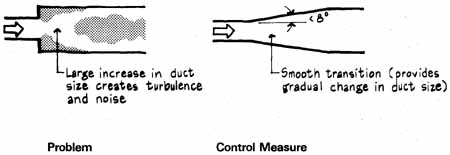Fans produce less noise when the inlet air stream (e.g., ducted return air) is smooth and uniform, not turbulent. Consequently, in-duct obstructions and turns should not occur close to fans. At high air velocities, any abrupt change in direction (dog-legged turn) or cross section (transition) causes airflow to separate from the duct walls resulting in turbulence. This can occur over a distance of more than 5 times the duct diameter (equivalent diameter for a rectangular duct is "v" 1 .3A, where A is open area of duct). Shown below are ex ample air duct elements which can produce turbulence and noise; control measures are at the right.
Turns
Turns should be smooth with fans and fittings located sufficient distances away so disturbed flow can dissipate. Lining turns (or elbows) with glass fiber can reduce noise. For example, a lined 90° elbow (small inside duct dimension <36 in) can provide attenuation of 3 to 10 dB from 250 to 8000 Hz, if the lining extends 10 ft on both sides of elbow.
Note: Perforated, double-radius turning vanes that have a sound-absorbing core to reduce airflow noise at elbows and tees are commercially available.
Transitions
Changes in duct sizes should be gradually tapered (< 8 ) to reduce turbulence and noise.
Takeoffs
Branch takeoffs should be curved or chamfered because abrupt takeoffs can generate considerable noise.
Next: Fan Room Treatment
